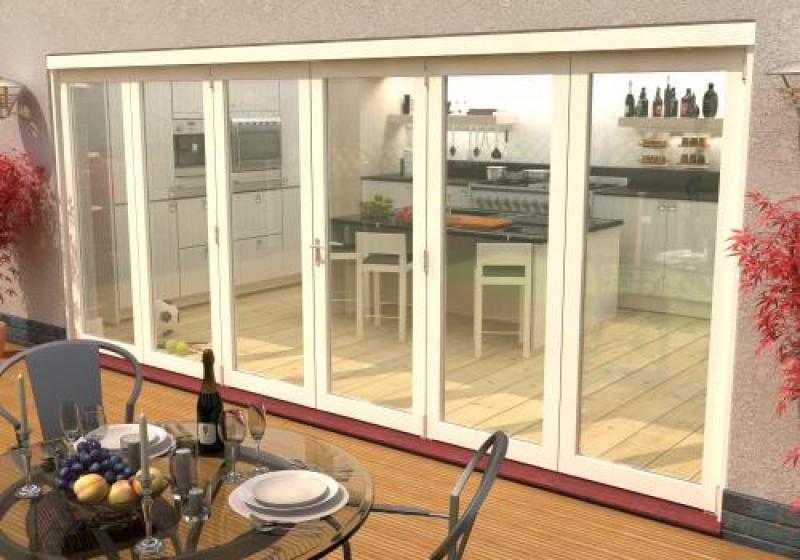Express Doors Direct ▸ Blog ▸ How to Winter-Proof Patio Doors: Insulation & Maintenance
Last updated on September 16th, 2024 at 04:22 pm
Doors and windows represent the thermal weak-points of any property. And this is especially so in the case of patio doors. Whether it’s of the bi-fold, French or sliding variety, a patio door presents the elements with plenty of cracks to slip through, and the warmth inside your home with plenty of glass through which to escape.
But never fear: there are steps we might take to limit this. In doing so, we’ll ensure that our interiors are kept as toasty-warm as possible and that those energy bills aren’t allowed to spiral out of control.
How Do I Insulate My Patio Doors?
When considering how to insulate patio doors, we need to ensure not only that heat energy is prevented from moving from one side of the door to the other, but that moisture and wind can’t rush through the cracks around the edges. In the case of a door, this is even more complicated, as it needs to be able to open and close.
The Basics
Draughts around the bottom of your door can typically be kept at bay using a draft excluder. These are long, cylindrical cushions which sit at the bottom of your door. They help to block any gaps around the bottom to minimize drafts. It’s a temporary solution but can be effective in helping to keep your home warm.

Take a look at our detailed post on choosing the right draught excluder.
Check the door track for small stones and other obstructions, and run a vacuum cleaner along the bottom of the track to pick up all of those stray dust particles. For best results, spray the track with WD40 and run the door back and forth a few times to ensure that the lubricant is properly distributed.
If you have a sliding glass patio door or bi-fold door, then it might have been unseated from its rail, which will cause the gaps around the edges to grow. If necessary, re-seat the door.
Insulating French Doors
Outward-opening French doors might also benefit from having their weather-stripping replaced. This is the compressible plastic that runs around the edge of the door. Over time, thousands of compressions will rob the material of its elasticity.

This means that it won’t expand to the same size, and thus it won’t form a tight seal around the edge of the door. By replacing the sealing, you’ll hugely improve the door’s draught-excluding abilities – sealing of this sort can often be bought cheaply, and it’ll snap into place rather than needing to be glued.
How to Insulate Sliding Glass Doors
Let’s think for a moment about how to winter-proof a sliding glass door. Sliding doors can’t use compressible seals, as they need to be able to move back and forth. Instead, brush-style seals are preferred. These, too, might benefit from an occasional replacement.
Check the exterior caulk and replace if necessary. Your sliding door might need the sealant replacing for effective insulation. Check around the door frame for any damaged caulk or gaps that might let the cool air through.
Bifold Door Insulation
Replacing or installing weather stripping can help to insulate bifold doors. This helps to minimise air leaks and reduce heat transfer. Just like sliding doors, new weather stripping can make a big difference if it has aged or deteriorated.
Repair & Replacement
Double-glazed glass tends to be less thermally conductive than the frame into which it’s built. As such, doors which incorporate lots of it tend to be more thermally efficient than you might expect. If it’s triple-glazed glass, then this is especially so.
With that said, double-glazing does have a lifespan. If you can see condensation forming between the panels, it means that the seal has failed and that all of the inert, insulating gas has rushed out. That being the case, you might need to replace the glass insert – or, better yet, the entire door.
Modern glass doors are much more energy-efficient than their older counterparts. This is down to improvements in the manufacturing process that helps to create products that minimise heat loss.
How Should I Dress the Doors? Curtains & Blinds
Another way to improve energy efficiency is to install heavy or insulated curtains (or roman blinds) onto the interior of the door. You might alternatively attach a blackout lining to the rear of a set of existing curtains. Lightweight curtains and blinds might be able to control the light levels, but they’ll do little to prevent hot air from moving from one part of the room to the other.

Thermal curtains will prevent the warm air in the room from mixing with the cold air around the window, and thereby slow the transfer of heat from the interior of the building to the outside. This can only happen, however, if the curtains in question are drawn; make sure you do this when you aren’t in the room, and when it gets dark outside.
Other budget-friendly tips and tricks
- If you have single glazing, adding plastic window film can help to provide some extra insulation.
- Keep curtains and blinds drawn at night for insulation but keep them open during the day to make the most of the natural heat from the sunlight.
- Block drafts with draft stoppers, an easy way to insulate sliding patio doors – you can even make your own!
According to the Energy Saving Trust, draught-proofing doors and windows can save the average household around £35 per year. Checkatrade suggest this could go up to as much as £44 a year in savings on your energy bills.
How Do I Weather-proof My Patio Doors?
Winter is a time of year where your door will be exposed to a great deal of moisture. For this reason, it’s important that it’s properly protected. In the case of uPVC and aluminium doors, this isn’t such a concern; the former are designed never to be finished or painted, while the latter are given a lasting coat of powder-finish at factory level. Other than applying a mechanical lubricant to any moving or exposed metal parts, there’s not a great deal to be done.

With timber doors, things are a little bit different. You’ll need to give them the occasional refinish to prevent moisture from penetrating the wood fibres and causing warping, rot and other problems. We’d suggest doing this during summer, as it’ll allow you to wash the frames and have them dry quickly in preparation for a coat or two of treatment.
How Do I Clean Patio Doors?
During the winter months, dirt and condensation can quickly accumulate on your glass. For this reason, it’s a good idea to give it the once over on the inside and outside. Use an acidic substance like vinegar and some scrunched-up newspaper. You can get ready-mixed window cleaner too, which does the job quickly and easily.

We’d also suggest giving the same treatment to the mechanisms that go into the doors. That means lubricating and wiping any hinges, as well as the tracks we’ve mentioned.
You can also spread a little bit of graphite oil into the latches and locking mechanisms; this will ensure that heat is allowed to easily circulate, and that you won’t get any patches of ice seizing up the door.
Get Ready Early, Stay Warm and Cosy
Preparing your patio doors for winter needn’t be an enormous job – especially if you do a little bit every year rather than allowing the door to deteriorate and thereby giving yourself a mountain to climb.
We’d suggest getting it all out of the way as early as possible rather than letting the work drag on all winter. The sooner you get the door into good condition, the sooner you’ll be able to enjoy the benefits!
FAQs
Can you insulate patio doors?
Yes, you can insulate patio doors by replacing or adding weatherproofing strips. This method effectively keeps out draughts and moisture. It’s a simple DIY task that improves energy efficiency and comfort in your home.
How can I make my patio doors warmer?
To make your patio doors warmer, use thermal curtains or drapes to prevent heat loss and block cold drafts. Applying window film or insulating plastic adds an extra layer of protection. Both methods effectively enhance insulation and improve warmth during the winter.
How do you draught proof patio doors?
To draught proof patio doors, use weather stripping around the edges and install a draft excluder at the bottom. Additionally, applying foam or plastic insulation panels on the sliding areas can significantly reduce drafts and increase energy efficiency.
How to stop condensation on patio doors in winter?
To stop condensation on patio doors in winter, use a dehumidifier to reduce indoor humidity, ensure proper ventilation by opening windows or using exhaust fans, and install weatherstripping to seal any gaps around the doors. These steps can significantly minimize condensation problems.
Related Posts:

Shop bestsellers and see what's new in at expressdoorsdirect.co.uk/internal-french-doors



Make a note of these if you're planning on placing an order or contacting our team in the next few days.
Shop online at expressdoorsdirect.co.uk as usual and we'll pick everything up when we get back. Thanks!



Get your space set up for summer with a discount on our bestselling black heritage style #frenchdoors T&Cs apply.
Browse all offers at expressdoorsdirect.co.uk/special-door-offers
@followers





Buy great value, energy efficient #PatioDoors that complement the style of any property.
Shop standard sizes in on-trend designs or ask our experts about custom doors made to measure.
 Explore our collection at expressdoorsdirect.co.uk/patio-doors
Explore our collection at expressdoorsdirect.co.uk/patio-doors Glad we could supply all the #FireDoors needed for this project DMD Internal Doors
Glad we could supply all the #FireDoors needed for this project DMD Internal Doors 
#doorinstallation #doorsupplier #joinery #derbyshire







































































